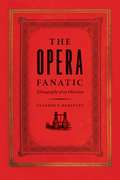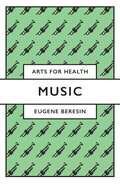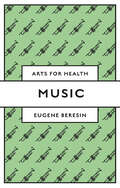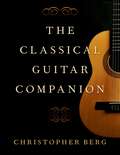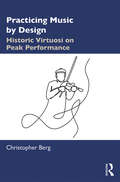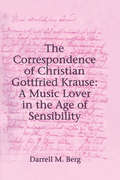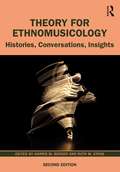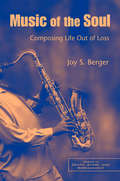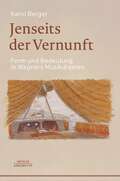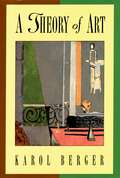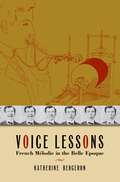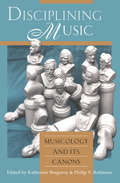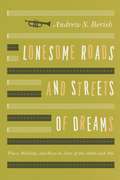- Table View
- List View
The Opera Fanatic: Ethnography of an Obsession
by Claudio E. BenzecryThough some dismiss opera as old-fashioned, it shows no sign of disappearing from the world’s stage. So why do audiences continue to flock to it? Given its association with wealth, one might imagine that opera tickets function as a status symbol. But while a desire to hobnob with the upper crust might motivate the occasional operagoer, for hardcore fans the real answer, according to The Opera Fanatic, is passion—they do it for love. Opera lovers are an intense lot, Claudio E. Benzecry discovers in his look at the fanatics who haunt the legendary Colón Opera House in Buenos Aires, a key site for opera’s globalization. Listening to the fans and their stories, Benzecry hears of two-hundred-mile trips for performances and nightlong camp-outs for tickets, while others testify to a particular opera’s power to move them—whether to song or to tears—no matter how many times they have seen it before. Drawing on his insightful analysis of these acts of love, Benzecry proposes new ways of thinking about people’s relationship to art and shows how, far from merely enhancing aspects of everyday life, art allows us to transcend it.
The Opera Fanatic: Ethnography of an Obsession
by Claudio E. BenzecryThough some dismiss opera as old-fashioned, it shows no sign of disappearing from the world’s stage. So why do audiences continue to flock to it? Given its association with wealth, one might imagine that opera tickets function as a status symbol. But while a desire to hobnob with the upper crust might motivate the occasional operagoer, for hardcore fans the real answer, according to The Opera Fanatic, is passion—they do it for love. Opera lovers are an intense lot, Claudio E. Benzecry discovers in his look at the fanatics who haunt the legendary Colón Opera House in Buenos Aires, a key site for opera’s globalization. Listening to the fans and their stories, Benzecry hears of two-hundred-mile trips for performances and nightlong camp-outs for tickets, while others testify to a particular opera’s power to move them—whether to song or to tears—no matter how many times they have seen it before. Drawing on his insightful analysis of these acts of love, Benzecry proposes new ways of thinking about people’s relationship to art and shows how, far from merely enhancing aspects of everyday life, art allows us to transcend it.
The Opera Fanatic: Ethnography of an Obsession
by Claudio E. BenzecryThough some dismiss opera as old-fashioned, it shows no sign of disappearing from the world’s stage. So why do audiences continue to flock to it? Given its association with wealth, one might imagine that opera tickets function as a status symbol. But while a desire to hobnob with the upper crust might motivate the occasional operagoer, for hardcore fans the real answer, according to The Opera Fanatic, is passion—they do it for love. Opera lovers are an intense lot, Claudio E. Benzecry discovers in his look at the fanatics who haunt the legendary Colón Opera House in Buenos Aires, a key site for opera’s globalization. Listening to the fans and their stories, Benzecry hears of two-hundred-mile trips for performances and nightlong camp-outs for tickets, while others testify to a particular opera’s power to move them—whether to song or to tears—no matter how many times they have seen it before. Drawing on his insightful analysis of these acts of love, Benzecry proposes new ways of thinking about people’s relationship to art and shows how, far from merely enhancing aspects of everyday life, art allows us to transcend it.
The Opera Fanatic: Ethnography of an Obsession
by Claudio E. BenzecryThough some dismiss opera as old-fashioned, it shows no sign of disappearing from the world’s stage. So why do audiences continue to flock to it? Given its association with wealth, one might imagine that opera tickets function as a status symbol. But while a desire to hobnob with the upper crust might motivate the occasional operagoer, for hardcore fans the real answer, according to The Opera Fanatic, is passion—they do it for love. Opera lovers are an intense lot, Claudio E. Benzecry discovers in his look at the fanatics who haunt the legendary Colón Opera House in Buenos Aires, a key site for opera’s globalization. Listening to the fans and their stories, Benzecry hears of two-hundred-mile trips for performances and nightlong camp-outs for tickets, while others testify to a particular opera’s power to move them—whether to song or to tears—no matter how many times they have seen it before. Drawing on his insightful analysis of these acts of love, Benzecry proposes new ways of thinking about people’s relationship to art and shows how, far from merely enhancing aspects of everyday life, art allows us to transcend it.
The Opera Fanatic: Ethnography of an Obsession
by Claudio E. BenzecryThough some dismiss opera as old-fashioned, it shows no sign of disappearing from the world’s stage. So why do audiences continue to flock to it? Given its association with wealth, one might imagine that opera tickets function as a status symbol. But while a desire to hobnob with the upper crust might motivate the occasional operagoer, for hardcore fans the real answer, according to The Opera Fanatic, is passion—they do it for love. Opera lovers are an intense lot, Claudio E. Benzecry discovers in his look at the fanatics who haunt the legendary Colón Opera House in Buenos Aires, a key site for opera’s globalization. Listening to the fans and their stories, Benzecry hears of two-hundred-mile trips for performances and nightlong camp-outs for tickets, while others testify to a particular opera’s power to move them—whether to song or to tears—no matter how many times they have seen it before. Drawing on his insightful analysis of these acts of love, Benzecry proposes new ways of thinking about people’s relationship to art and shows how, far from merely enhancing aspects of everyday life, art allows us to transcend it.
The Opera Fanatic: Ethnography of an Obsession
by Claudio E. BenzecryThough some dismiss opera as old-fashioned, it shows no sign of disappearing from the world’s stage. So why do audiences continue to flock to it? Given its association with wealth, one might imagine that opera tickets function as a status symbol. But while a desire to hobnob with the upper crust might motivate the occasional operagoer, for hardcore fans the real answer, according to The Opera Fanatic, is passion—they do it for love. Opera lovers are an intense lot, Claudio E. Benzecry discovers in his look at the fanatics who haunt the legendary Colón Opera House in Buenos Aires, a key site for opera’s globalization. Listening to the fans and their stories, Benzecry hears of two-hundred-mile trips for performances and nightlong camp-outs for tickets, while others testify to a particular opera’s power to move them—whether to song or to tears—no matter how many times they have seen it before. Drawing on his insightful analysis of these acts of love, Benzecry proposes new ways of thinking about people’s relationship to art and shows how, far from merely enhancing aspects of everyday life, art allows us to transcend it.
Music (Arts for Health)
by Eugene BeresinMusic is an art form but also a social activity. It is a part of every human society, contributing to community, culture, and a sense of group identity. It is also fundamental to individual identity and personal well-being. In Music, Eugene Beresin traces the possible applications of musical expression for human health and happiness. At the heart of Music are powerful examples from the lives of real individuals, families, and populations. These stories cover a myriad of ages, instruments, situations, and purposes, to convey the universal power of music to help us all get more out of life. Offering practical ideas for integrating musical practice into a wide range of settings from the medical to the personal, Beresin provides a compelling evocation of the healing power of music. It is a must-read for practitioners, teachers, counsellors, and lovers of the art form.
Music (Arts for Health)
by Eugene BeresinMusic is an art form but also a social activity. It is a part of every human society, contributing to community, culture, and a sense of group identity. It is also fundamental to individual identity and personal well-being. In Music, Eugene Beresin traces the possible applications of musical expression for human health and happiness. At the heart of Music are powerful examples from the lives of real individuals, families, and populations. These stories cover a myriad of ages, instruments, situations, and purposes, to convey the universal power of music to help us all get more out of life. Offering practical ideas for integrating musical practice into a wide range of settings from the medical to the personal, Beresin provides a compelling evocation of the healing power of music. It is a must-read for practitioners, teachers, counsellors, and lovers of the art form.
The Classical Guitar Companion
by Christopher BergThe Classical Guitar Companion is an anthology of guitar exercises, etudes, and pieces organized according to technique or musical texture. Expert author Christopher Berg, a veteran guitar instructor, bring together perspectives as an active performing artist and as a teacher who has trained hundreds of guitarists to encourages students to work based on their own strengths and weaknesses. The book opens with "Learning the Fingerboard", a large section devoted to establishing a thorough knowledge of the guitar fingerboard through a systematic and rigorous study of scales and fingerboard harmony, which will lead to ease and fluency in sight-reading and will reduce the time needed to learn a repertoire piece. The following sections "Scales and Scale Studies", "Repeated Notes", "Slurs", "Harmony", "Arpeggios", "Melody with Accompaniment", "Counterpoint" and "Florid or Virtuoso Studies" each contain text and examples that connect material to fingering practices of composers and practice strategies to open a path to interpretive freedom in performance. The Classical Guitar Companion will serve as a helpful companion for many years of guitar study.
The Classical Guitar Companion
by Christopher BergThe Classical Guitar Companion is an anthology of guitar exercises, etudes, and pieces organized according to technique or musical texture. Expert author Christopher Berg, a veteran guitar instructor, bring together perspectives as an active performing artist and as a teacher who has trained hundreds of guitarists to encourages students to work based on their own strengths and weaknesses. The book opens with "Learning the Fingerboard", a large section devoted to establishing a thorough knowledge of the guitar fingerboard through a systematic and rigorous study of scales and fingerboard harmony, which will lead to ease and fluency in sight-reading and will reduce the time needed to learn a repertoire piece. The following sections "Scales and Scale Studies", "Repeated Notes", "Slurs", "Harmony", "Arpeggios", "Melody with Accompaniment", "Counterpoint" and "Florid or Virtuoso Studies" each contain text and examples that connect material to fingering practices of composers and practice strategies to open a path to interpretive freedom in performance. The Classical Guitar Companion will serve as a helpful companion for many years of guitar study.
Practicing Music by Design: Historic Virtuosi on Peak Performance
by Christopher BergPracticing Music by Design: Historic Virtuosi on Peak Performance explores pedagogical practices for achieving expert skill in performance. It is an account of the relationship between historic practices and modern research, examining the defining characteristics and applications of eight common components of practice from the perspectives of performing artists, master teachers, and scientists. The author presents research past and present designed to help musicians understand the abstract principles behind the concepts. After studying Practicing Music by Design, students and performers will be able to identify areas in their practice that prevent them from developing.The tenets articulated here are universal, not instrument-specific, borne of modern research and the methods of legendary virtuosi and teachers. Those figures discussed include: Luminaries Franz Liszt and Frederic Chopin Renowned performers Anton Rubinstein, Mark Hambourg, Ignace Paderewski, and Sergei Rachmaninoff Extraordinary teachers Theodor Leschetizky, Rafael Joseffy, Leopold Auer, Carl Flesch, and Ivan Galamian Lesser-known musicians who wrote perceptively on the subject, such as violinists Frank Thistleton, Rowsby Woof, Achille Rivarde, and Sydney Robjohns Practicing Music by Design forges old with new connections between research and practice, outlining the practice practices of some of the most virtuosic concert performers in history while ultimately addressing the question: How does all this work to make for better musicians and artists?
Practicing Music by Design: Historic Virtuosi on Peak Performance
by Christopher BergPracticing Music by Design: Historic Virtuosi on Peak Performance explores pedagogical practices for achieving expert skill in performance. It is an account of the relationship between historic practices and modern research, examining the defining characteristics and applications of eight common components of practice from the perspectives of performing artists, master teachers, and scientists. The author presents research past and present designed to help musicians understand the abstract principles behind the concepts. After studying Practicing Music by Design, students and performers will be able to identify areas in their practice that prevent them from developing.The tenets articulated here are universal, not instrument-specific, borne of modern research and the methods of legendary virtuosi and teachers. Those figures discussed include: Luminaries Franz Liszt and Frederic Chopin Renowned performers Anton Rubinstein, Mark Hambourg, Ignace Paderewski, and Sergei Rachmaninoff Extraordinary teachers Theodor Leschetizky, Rafael Joseffy, Leopold Auer, Carl Flesch, and Ivan Galamian Lesser-known musicians who wrote perceptively on the subject, such as violinists Frank Thistleton, Rowsby Woof, Achille Rivarde, and Sydney Robjohns Practicing Music by Design forges old with new connections between research and practice, outlining the practice practices of some of the most virtuosic concert performers in history while ultimately addressing the question: How does all this work to make for better musicians and artists?
The Correspondence of Christian Gottfried Krause: A Music Lover in the Age of Sensibility
by Darrell M. BergThe fascinating correspondence of the Berlin lawyer and musician Christian Gottfried Krause is an important document reflecting the trends and developments in aesthetics, music theory and music making in the Prussian capital during the reign of Frederick the Great. Krause's letters shed light on the rise of a bourgeois music culture, which during h
The Correspondence of Christian Gottfried Krause: A Music Lover in the Age of Sensibility
by Darrell M. BergThe fascinating correspondence of the Berlin lawyer and musician Christian Gottfried Krause is an important document reflecting the trends and developments in aesthetics, music theory and music making in the Prussian capital during the reign of Frederick the Great. Krause's letters shed light on the rise of a bourgeois music culture, which during h
Music Therapy, Sensory Integration and the Autistic Child
by Dorita S. BergerMusic's ability to influence emotions and moods is universally acknowledged, and music therapists have long known that stimulating the brain through the auditory system is a key to obtaining remarkable responses. Music therapy is a particularly effective tool when working with children with autism spectrum conditions, because music communicates with these children on a level where mere words cannot go. Written in a way that is both informative for the professional and accessible for parents, this book furthers the already strong case for the use of music therapy as a resource to encourage behavioural changes for the better in children with autism spectrum conditions. Placing particular emphasis upon sensory integration, the author discusses contributing factors to the behaviour of people on the autism spectrum, and, through the use of case studies, presents the latest approaches in music therapy that are enabling children with autism spectrum conditions to better cope with sensory integration.
Music Therapy, Sensory Integration and the Autistic Child (PDF)
by Dorita S. BergerMusic's ability to influence emotions and moods is universally acknowledged, and music therapists have long known that stimulating the brain through the auditory system is a key to obtaining remarkable responses. Music therapy is a particularly effective tool when working with children with autism spectrum conditions, because music communicates with these children on a level where mere words cannot go. Written in a way that is both informative for the professional and accessible for parents, this book furthers the already strong case for the use of music therapy as a resource to encourage behavioural changes for the better in children with autism spectrum conditions. Placing particular emphasis upon sensory integration, the author discusses contributing factors to the behaviour of people on the autism spectrum, and, through the use of case studies, presents the latest approaches in music therapy that are enabling children with autism spectrum conditions to better cope with sensory integration.
Theory for Ethnomusicology: Histories, Conversations, Insights
by Harris M. Berger Ruth M. StoneTheory for Ethnomusicology: Histories, Conversations, Insights, Second Edition, is a foundational work for courses in ethnomusicological theory. The book examines key intellectual movements and topic areas in social and cultural theory, and explores the way they have been taken up in ethnomusicological research. New co-author Harris M. Berger and Ruth M. Stone investigate the discipline’s past, present, and future, reflecting on contemporary concerns while cataloging significant developments since the publication of the first edition in 2008. A dozen contributors approach a broad range of theoretical topics alive in ethnomusicology. Each chapter examines ethnographic and historical works from within ethnomusicology, showcasing the unique contributions scholars in the field have made to wider, transdisciplinary dialogs, while illuminating the field’s relevance and pointing the way toward new horizons of research. New to this edition: Every chapter in the book is completely new, with richer and more comprehensive discussions. New chapters have been added on gender and sexuality, sound and voice studies, performance and critical improvisation studies, and theories of participation. New text boxes and notes make connections among the chapters, emphasizing points of contact and conflict among intellectual movements.
Theory for Ethnomusicology: Histories, Conversations, Insights
by Harris M. Berger Ruth M. StoneTheory for Ethnomusicology: Histories, Conversations, Insights, Second Edition, is a foundational work for courses in ethnomusicological theory. The book examines key intellectual movements and topic areas in social and cultural theory, and explores the way they have been taken up in ethnomusicological research. New co-author Harris M. Berger and Ruth M. Stone investigate the discipline’s past, present, and future, reflecting on contemporary concerns while cataloging significant developments since the publication of the first edition in 2008. A dozen contributors approach a broad range of theoretical topics alive in ethnomusicology. Each chapter examines ethnographic and historical works from within ethnomusicology, showcasing the unique contributions scholars in the field have made to wider, transdisciplinary dialogs, while illuminating the field’s relevance and pointing the way toward new horizons of research. New to this edition: Every chapter in the book is completely new, with richer and more comprehensive discussions. New chapters have been added on gender and sexuality, sound and voice studies, performance and critical improvisation studies, and theories of participation. New text boxes and notes make connections among the chapters, emphasizing points of contact and conflict among intellectual movements.
Music of the Soul: Composing Life Out of Loss (Series in Death, Dying, and Bereavement)
by Joy S. BergerMusic of the Soul guides the reader through principles, techniques, and exercises for incorporating music into grief counseling, with the end goal of further empowering the grieving person. Music has a unique ability to elicit a whole range of powerful emotional responses in people - even so far as altering or enhancing one's mood - as well as physical reactions. This interdisciplinary text draws in equal parts from contemporary grief/loss theory, music therapy research, historical examples of powerful music, case studies, and both self-reflecting and teaching exercises. Music is as much about beginnings as endings, and thus the book moves through life’s losses into its new beginnings, using musical expression to help the bereaved find meaning in loss and hurt, and move forward with their lives. With numerous exercises and examples for implementing the use of music in grief counseling, the book offers a practical and flexible approach to a broad spectrum of mental health practitioners, from thanatologists to hospice staff, at all levels of professional training and settings.
Music of the Soul: Composing Life Out of Loss (Series in Death, Dying, and Bereavement)
by Joy S. BergerMusic of the Soul guides the reader through principles, techniques, and exercises for incorporating music into grief counseling, with the end goal of further empowering the grieving person. Music has a unique ability to elicit a whole range of powerful emotional responses in people - even so far as altering or enhancing one's mood - as well as physical reactions. This interdisciplinary text draws in equal parts from contemporary grief/loss theory, music therapy research, historical examples of powerful music, case studies, and both self-reflecting and teaching exercises. Music is as much about beginnings as endings, and thus the book moves through life’s losses into its new beginnings, using musical expression to help the bereaved find meaning in loss and hurt, and move forward with their lives. With numerous exercises and examples for implementing the use of music in grief counseling, the book offers a practical and flexible approach to a broad spectrum of mental health practitioners, from thanatologists to hospice staff, at all levels of professional training and settings.
Jenseits der Vernunft: Form und Bedeutung in Wagners Musikdramen
by Karol BergerKarol Berger setzt Wagners Musikdramen in Beziehung zu den philosophischen und kulturellen Ideen seiner Zeit und konzentriert sich dabei in einer ausführlichen und gut verständlichen Analyse auf die vier Werke, die dieser in der zweiten Hälfte seiner Karriere schuf: „Der Ring des Nibelungen“, „Tristan und Isolde“, „Die Meistersinger von Nürnberg“ und „Parsifal“. Der Autor versucht, in das Geheimnis der Großform von Wagners Musikdramen einzudringen und erzielt überraschende Ergebnisse wie die Nähe Wagners zur italienischen Oper. Bei seiner Einordnung der Musikdramen auf der ideologischen Landkarte seiner Zeit relativieren sich, ganz gegen des Autors ursprüngliche Absicht, viele Einwände von Wagners Kritikern, allen voran Nietzsche.
A Theory of Art
by Karol BergerWhat, if anything, has art to do with the rest of our lives, and in particular with those ethical and political issues that matter to us most? Will art created today be likely to play a role in our lives as profound as that of the best art of the past? A Theory of Art shifts the focus of aesthetics from the traditional debate of "what is art?" to the engaging question of "what is art for?" Skillfully describing the social and historical situation of art today, author Karol Berger argues that music exemplifies the current condition of art in a radical, acute, and revealing fashion. He also uniquely combines aesthetics with poetics and hermeneutics. Offering a careful synthesis of a wide breadth of scholarship from art history, musicology, literary studies, political philosophy, ethics, and metaphysics, and written in a clear, accessible style, this book will appeal to anyone with a serious interest in the arts.
Voice Lessons: French Mélodie in the Belle Epoque (New Cultural History of Music)
by Katherine BergeronLanguage, education, politics, and music come together in Katherine Bergeron's Voice Lessons, a study of the French mélodie in the Belle Epoque. Close readings of songs by Fauré, Debussy, and Ravel, along with poems, sound recordings, and other historical documents, seek to uncovers the cultural meanings of this art: why it emerged, why it mattered, and why it eventually disappeared.
Disciplining Music: Musicology and Its Canons
by Katherine Bergeron Philip V. BohlmanProvocative and timely, Disciplining Music confronts a topic that has sparked considerable debate in recent years: how do musicians and music scholars "discipline" music in their efforts to confer order and meaning on it? This collection of essays addresses this issue by formulating questions about music's canons—rules that measure and order, negotiate cultural constraints, reconstruct the past, and shape the future. Written by scholars representing the fields of historical musicology, ethnomusicology, and music theory, many of the essays tug and push at the very boundaries of these traditional division within the study of music. "Fortunately, in a blaze of good-humored . . . scholarship, [this] book helps brains unaccustomed to thinking about the future without jeopardizing the past imagine the wonder classical-music life might become if it embraced all people and all musics."—Laurence Vittes, Los Angeles Reader "These essays will force us to rethink our position on many issues. . . [and] advance musicology into the twenty-first century."—Giulio Ongaro, American Music Teacher With essays by Katherine Bergeron, Philip V. Bohlman, Richard Cohn and Douglas Dempster, Philip Gossett, Robert P. Morgan, Bruno Nettl, Don Michael Randel, Ruth A. Solie, and Gary Tomlinson.
Lonesome Roads and Streets of Dreams: Place, Mobility, and Race in Jazz of the 1930s and '40s
by Andrew S. BerishAny listener knows the power of music to define a place, but few can describe the how or why of this phenomenon. In Lonesome Roads and Streets of Dreams: Place, Mobility, and Race in Jazz of the 1930s and ’40s, Andrew Berish attempts to right this wrong, showcasing how American jazz defined a culture particularly preoccupied with place. By analyzing both the performances and cultural context of leading jazz figures, including the many famous venues where they played, Berish bridges two dominant scholarly approaches to the genre, offering not only a new reading of swing era jazz but an entirely new framework for musical analysis in general, one that examines how the geographical realities of daily life can be transformed into musical sound. Focusing on white bandleader Jan Garber, black bandleader Duke Ellington, white saxophonist Charlie Barnet, and black guitarist Charlie Christian, as well as traveling from Catalina Island to Manhattan to Oklahoma City, Lonesome Roads and Streets of Dreams depicts not only a geography of race but how this geography was disrupted, how these musicians crossed physical and racial boundaries—from black to white, South to North, and rural to urban—and how they found expression for these movements in the insistent music they were creating.
